|
W.G. Tomlinson was born at Leavenworth, KS, December 17, 1897. He graduated from the Naval Academy in 1919. After three years as a line officer, he went to Pensacola for flight training. He became a Naval Aviator (No. 3,070) and in March, 1923, joined the Battle Fleet, Fighting Plane Squadron 2 and participated in fleet maneuvers.
W.G. Tomlinson, Date & Location Unknown (Source: NASM)
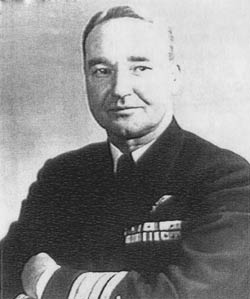 |
Tomlinson visited Tucson once, on Wednesday, June 19, 1929. He was piloting Ford trimotor A-7526. He carried a single passenger he identified as the "Assistant Secretary of the Navy." The Secretary in June, 1929 would have been Ernest Lee Jahneke. Based at Washington, DC, Anacostia, they were westbound from El Paso, TX to Los Angeles, CA. No purpose was given in the Register, but see below for the context of their trip west that was assembled from several sources. At the link for their airplane you'll discover that A-7526 visited Tucson numerous times with different Navy pilots at the controls.
During the 1920s, an international competition known as the Schneider Cup Races was held. Tomlinson was assigned to the Navy Racing Team in July, 1926. The US government entered the annual event three times, in 1923, 1925, and 1926. The U.S. Navy won first and second place in the 1923 contest and the Army won first place in the 1925 event, with Register pilot James Doolittle at the controls of a Curtiss R3C-2.
The 1926 race, held on November 13th at Norfolk, VA, was entered by Tomlinson and one other Navy pilot. They won second and fourth places. The aircraft Tomlinson was supposed to fly (a Curtiss R3C, below) was destroyed in an accident a day before the race. The New York TImes of November 13th reported the previous day's trial, "... almost cost the life of its pilot, Lieutenant William Gosnell Tomlinson, who escaped without injury in a manner little short of miraculous. His plane turned a side somersault when one of its pontoons hit a wave in landing, and sank with its pilot squeezed into its tiny cockpit. Clad in heavy flying togs and strapped in his seat, Lieutenant Tomlinson was submerged in the cold waters of Willoughby Bay for some seconds." Spectators at the trial, "... including many notables in the realm of aviation, gasped and shuddered. Then they saw him crawl out o f the water to the top of one of the upturned pontoons of the capsized plane and wave his hand in reassurance to those ashore. Launches and seaplanes sped to his rescue."
The following day, instead of his wrecked race plane, Tomlinson qualified and flew a stock Curtiss F6C-1 Hawk. Tomlinson was the fourth (last) place contestant at one hour, 35 minutes and 16.72 seconds, averaging 136.96 MPH. This was slow when compared to the 246 MPH averaged by the winner, Mario de Bernardi of Italy, but it was a good average speed for the Curtiss he flew. Statistics for the race, including lap speeds by contestants, was covered by the New York TImes of November 14th.
Curtiss R3C, Ca. 1926 (Source: NASM)
 |
He entered other races in the 20s as a representative of the Navy. Then lieutenant Tomlinson won the pursuit race in Baltimore on Memorial Day, 1927. Below, from the Bureau of Aeronautics Newsletter of June 2, 1927, is a description of the results.
Bureau of Aeronautics Newsletter, June 2, 1927 (Source: Webmaster)
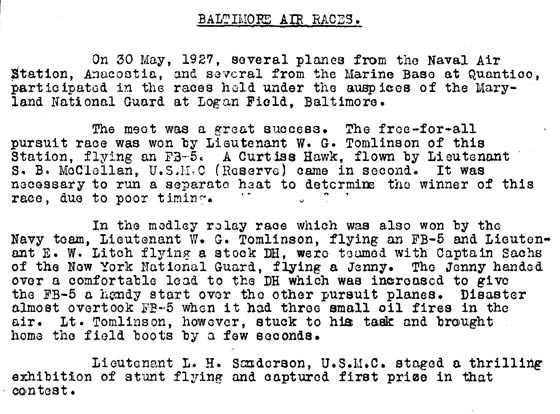 |
He and the Navy leveraged his successes via exhibitions around the country. Below from the Bureau of Aeronautics Newsletter, a commendation received by Tomlinson and another officer for exhibition work at Kansas City.
Bureau of Aeronautics Newsletter, September 7, 1927 (Source: Webmaster)
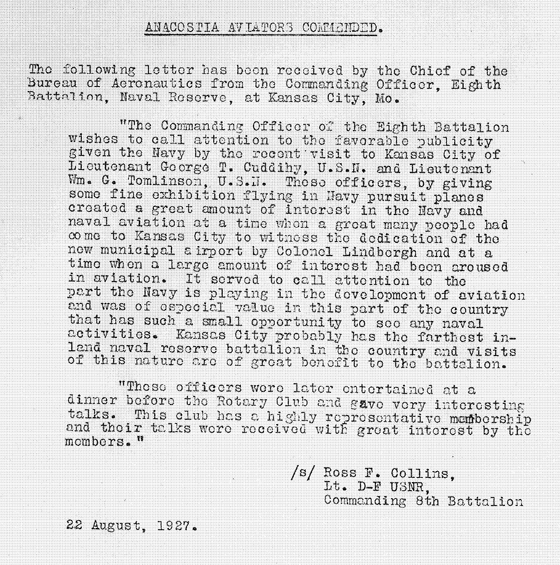 |
Tomlinson also competed in the 1928 Baltimore Air Races as documented in the Bureau of Aeronautics Newsletter, May 30, 1928 below.
Bureau of Aeronautics Newsletter, May 30, 1928 (Source: Webmaster)
 |
Tomlinson competed in the 1928 Curtiss Marine Trophy Race, placing first in the training plane category. The results were reported over two pages in the Bureau of Aeronautics Newsletter, May 23, 1928, below.
Bureau of Aeronautics Newsletter, May 23, 1928 (Source: Webmaster)
 |
Second page below.
Bureau of Aeronautics Newsletter, May 23, 1928 (Source: Webmaster)
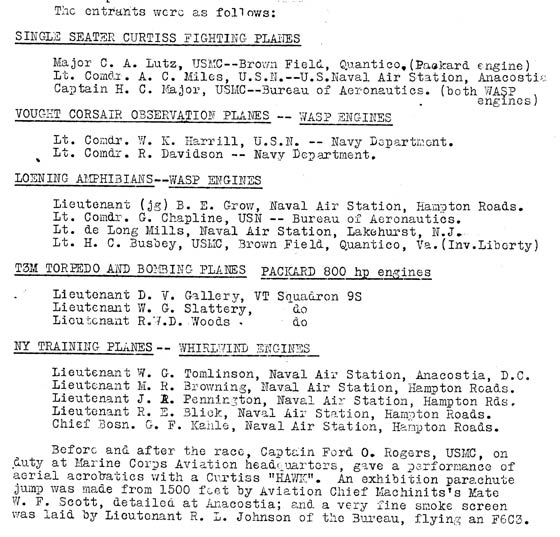 |
W.G. Tomlinson Ca. 1928 (Source: Popular Aviation)
 |
At right, from the July, 1928 issue of Popular Aviation, is a portrait of Tomlinson at the time of his Curtiss win.
Tomlinson also won the Curtiss Marine trophy for 1929 at the Anacostia Naval Air Station in May. His victory is recorded in the BuAeroNews of May 29, 1929, below.
Bureau of Aeronautics Newsletter, May 29, 1929 (Source: Webmaster)
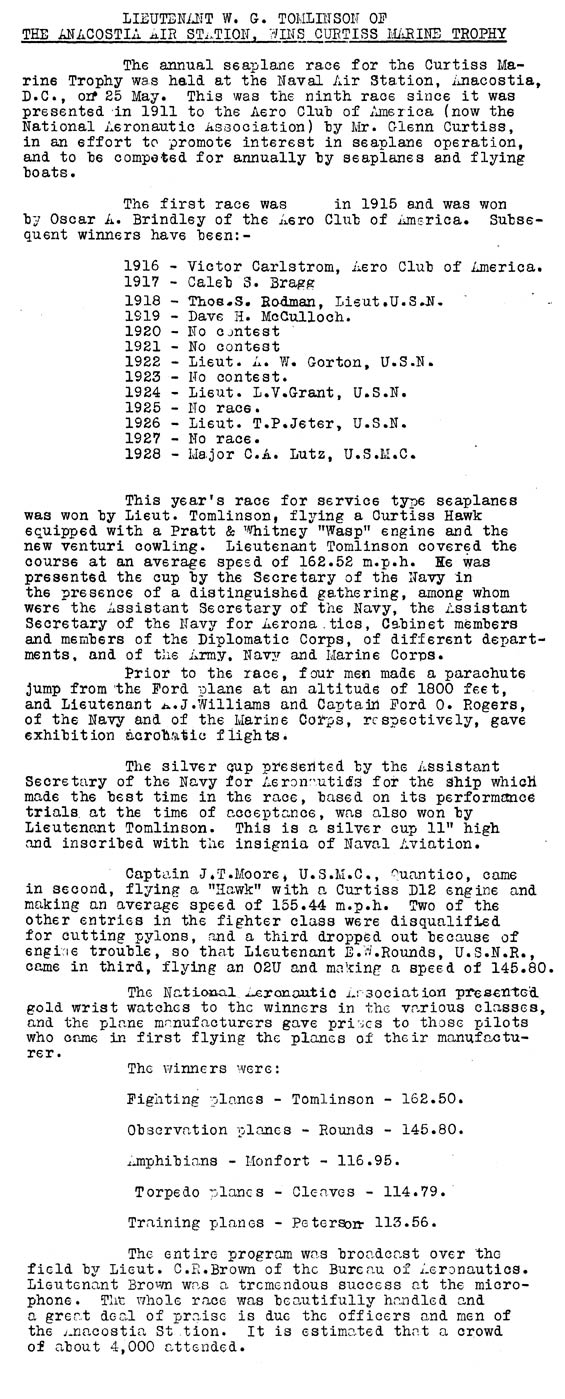 |
His participation in the Curtiss race was also documented in the New York Times of May 26, 1929, which states that, besides the Curtiss trophy he received a gold watch and a silver cigarette case.
He flew so fast during the 1929 race (in a Wasp-powered Curtiss Hawk on floats with the newly developed N.A.C.A. engine cowling installed) that he finished the 100-mile course before his nearest competitor had entered the final twenty miles. Having drawn 21st place in the start position lottery, he was in third place at the beginning of the third lap. He moved into first place and led to the finish. His speed of 175 MPH for the event was the fastest ever officially recognized for a military seaplane, although it was slower than speeds made by seaplanes constructed for the Schneider Cup contests. While a member of the Navy Racing Team in the late 20s he also served as photographic officer and member of various test boards at the Naval Air Station (N.A.S.), Anacostia, Washington, DC.
A month later he is found in the Register with the Assistant Secretary of the Navy, E.L. Jahncke as noted above. Jahncke served from April 1, 1929 to March 17, 1933.
Bureau of Aeronautics Newsletter, June 26, 1929 (Source: Webmaster)
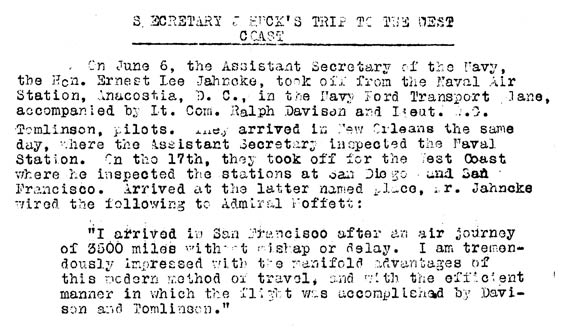 |
A second article in the BuAeroNews documented Jahncke's visit and landing aboard the Saratoga, below.
Bureau of Aeronautics Newsletter, July 10, 1929 (Source: Webmaster)
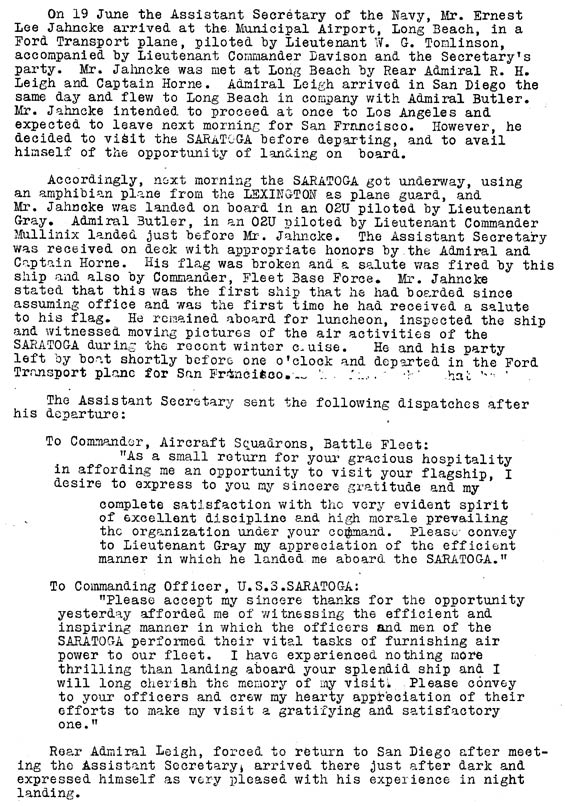 |
A couple of other issues of the BuAeroNews cited Jahncke"s itinerary around the west coast and beyond. The one below, from August 21st, summarizes his tour in more or less his own words. Tomlinson flew the long distance land legs.
Bureau of Aeronautics Newsletter, August 21, 1929 (Source: Webmaster)
 |
Tomlinson has a modest presence in the New York Times, having nearly a dozen articles about him between 1926 and 1951. Besides the ones cited above, on March 4, 1929 the Times reported on Herbert Hoover's inaugural festivities (the date wasn't fixed to January 20th until Roosevelt's second inauguration in 1937), which included a flyover of Army, Navy and Marine Corps aircraft, including the dirigible Los Angeles.
Fifty-five military planes participated, headed by Register signer Brigadier General Benjamin Folois (sic), who was assistant chief of the Army Air Corps at the time. Six squadrons, four from the Army and one each from the Navy and Marine Corps participated. Tomlinson led the Navy squadron. That number of aircraft involved significant management by Foulois, who staged the Army planes at Logan Field, Baltimore, MD and the squadrons of Navy and Marine aircraft at Quantico, VA before the event. Register signer Carl Spatz was the pilot of Foulois' command airplane, which was, ... decorated with red streamers."
This March 4th article is significant also because it cites, besides Tomlinson and other military pilots, the names of citizens who flew their personal craft to Washington for the event. Among them were several Register signers, e.g. Lee Schoenhair (sic), L. H. Atkinson, Ross Hoyt, Elwood Quesada and Billy Parker. It also cites a mass, transcontinental movement of bombers "last year." Indeed, they landed at Tucson during their trip, recording their presence in the Register on September 7, 1928. Aviation and aviators were still popular and newsworthy in 1929. The Times stated, perhaps fatefully, the air display was, "... to be staged as a symbol of the new age which is to be ushered in with the induction of Mr. Hoover."
The Times of March 16, 1929 mentions Tomlinson briefly in an article focused on Assistant Secretary Ingalls. Ingalls' first day in office was March 15th, and the article followed him to N.A.S. Anacostia for the first inspection of his administration. Significantly for naval aviation, he said he had, "... two major aims, the developemnt of naval aviation and the promotion of cooperation between the navy and army flying services." This article also places Tomlinson and Ingalls in Tucson (see above). Ingalls is quoted, "I am crazy about flying and am tickled to death to be back on the job. I expect to spend the few first months of my service at my desk learning the ropes. Once I have done this I plan to make a tour of all the stations, certainly within the next few months. I shall make the tour by air and hope to be able to accomplish as a result of the tour the fullest development possible of naval aviation." The tour was carried out in A-7526 and he passed through Tucson June 19th with Tomlinson at the controls.
The Times of May 24, 1930 has Tomlinson in line to participate in the Curtiss race, but he was "scratched" in favor of a Lt. F.J. Bridget. The Times of June 1, 1930 reports on the race and cites Tomlinson as being the winner in 1929. Significant in the 1930 race, however, is that all the first three places were flown by Register pilots.The winner was Capt. USMC Arthur H. Page; second was Lt. Navy A.P. Storrs and third was Lt. USMC J.E. Dyer.
The Times of August 24, 1930 documented the opening of the 1930 National Air Races held at Chicago. Tomlinson is cited as leading one group of Navy planes during the military airshow that showcased the beginning of the Races. Register pilots Victor Strahm, Mattias B. Gardner, A.P. Storrs, John Livingston, Willis H. Hale, James Doolittle and Frederick Trapnell also participated.
The Times of June 8, 1931 announced Tomlinson's planned wedding in Los Angeles on June 15 to debutante Katharine Dent. Tomlinson was cited as being, "... one of the most distinguished aviators in the United States Navy." He was attached to the Fifth Fighting Squadron with the Pacific Fleet, based in San Diego. The wedding ceremony was to take place at the St. John's Protestant Episcopal Church in Los Angeles. After the wedding they were scheduled to live at Coronado Beach until his tour of duty was finished in San Diego.
Later in the 30s, Tomlinson had a small role in developing the growing Naval Aviation infrastructure. In a hearing during March 1935, Tomlinson, who was introduced simply as an aviation officer directly identified with Naval and Marine Corps aviation, told the House Appropriations Committee: "The aviation cadet bill, if enacted, and if funds are provided to carry it out in accordance with the proposal of the Naval Department, will in time build Naval Reserve Aviation up to adequate numbers, and that will take care of the officer phase of it. If given proper authority, we can recruit enlisted men locally at the Reserve bases, enlist them, and train them so that they will be in a position to satisfactorily carry out their duties."
With the coming of WWII, Tomlinson was given positions of increasing responsibility. On September 16, 1942, Patrol Wing 12 was established at Key West, FL, Captain W. G. Tomlinson commanding, for operations under the Gulf Sea Frontier.
He earned the Navy Cross during WWII for his command of the light aircraft carrier USS Belleau Wood.
An interesting side note of his duty at Honolulu was his "meeting" (a hand shake, actually) and luncheon with President Truman on Friday October 13, 1950. This brief social contact with Truman was during a turn of a very historic wheel during the Korean conflict.
Truman was flying from Washington, DC to Wake Island to meet with General Douglas MacArthur. The link leads to a formal log of the trip made by Truman, October 11-18, 1950. Truman's post luncheon speech included, "It is necessary, after our conference with General MacArthur on the situation in Korea and Japan, for me to immediately return to San Francisco and tell the world what our policy is as it affects the world and world peace. And on the 24th of October I shall appear before the United Nations and try to drive the matter home in such a way that we may begin to arrive at a situation where we can have world peace and not world war. That is my sole ambition."
That meeting set Truman's expectations firmly with MacArthur. Soon, MacArthur pushed the limits of the President's mandate and increased the risk of war with China. Ultimately he was relieved of his duty as Commander in Chief of United Nations Forces on April 11, 1951.
One document from July, 1951 I reviewed cites Tomlinson as a Rear Admiral commanding Carrier Division Three in the Pacific during the Korean conflict. Other than that I have little information about Tomlinson post-WWII. Can anyone HELP? He died in Washington, DC in October, 1972 at age 74 . He is buried at the Arlington National Cemetery. A photograph of his grave is at the link.
---o0o---
Dossier 2.2.132
THIS PAGE UPLOADED: 01/27/11 REVISED: 04/02/11, 06/04/14
|













